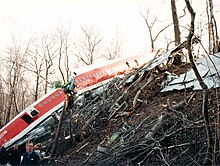Avianca Flight 52
Avianca Flight 52 was a scheduled flight from Bogotá to New York City. On January 25, 1990, the Boeing 707 (registered HK-2016) flying the route crashed after running out of fuel, killing 65 passengers and 8 crew members.
 Wreckage of the aircraft on the hillside in Cove Neck | |
| Accident | |
|---|---|
| Date | January 25, 1990 |
| Summary | Crashed following fuel exhaustion |
| Site | Cove Neck, New York 40°52′48″N 073°29′43″W / 40.88000°N 73.49528°W |
| Aircraft | |
| Aircraft type | Boeing 707-321B |
| Operator | Avianca |
| Call sign | AVIANCA 52 |
| Registration | HK-2016 |
| Flight origin | El Dorado International Airport |
| Stopover | José María Córdova Int'l Airport |
| Destination | John F. Kennedy Int'l Airport |
| Occupants | 158 |
| Passengers | 149 |
| Crew | 9 |
| Fatalities | 73 |
| Injuries | 85 |
| Survivors | 85 |
Aircraft
changeThe incident aircraft, HK-2016, was as Boeing 707 which flew for Avianca. The aircraft was made in 1967 and bought by Pan Am. Avianca bought the plane from Pan Am in 1977. The aircraft had flew for a total of 61,000 hours and was 22 years old.[1]: 21
Flight
changeOn January 25, 1990, the aircraft took off at 13:10 EST.[1]: 1–2 The flight first flew to a stopover airport in Medellín. More fuel was put into the aircraft, totaling 80,000 pounds (36,000 kg) of fuel, though other sources say that there was 82,000 pounds (37,000 kg) of fuel.[1]: 22–27
The flight took off from Medellín at 15:08.[1]: 1–2 It then entered the United States at 17:28.[1]: 1–2 [2][3] The airplane circled near Norfolk, Virginia from 19:04 to 19:23. The aircraft was then put into a holding pattern at 20:18.[1]: 177
Air traffic control told Flight 52 that there was an indefinite hold at JFK, and told Flight 52 that they could go to their other airport, which is used in case a plane cannot reach its destination. The pilots denied this, and stated they did not have enough fuel to reach their other airport.[1]: 4 At 20:46, the flight was cleared to go to JFK airport.[1]: 6
Attempt to land
changeAt 21:00, JFK airport was experiencing light drizzle with fog.[1]: 29 The landing gear was put out at 21:19.[1] The first officer then told the pilot that the plane was below the glideslope, a way to measure the rate a plane is going down while landing. The plane then went above and below the correct glideslope. The plane experienced a wind shear and the pilots made a missed approach.[1]: 10–11
After taking a left turn, the captain told the first officer to tell air traffic control they were in an emergency. The first officer told control that "we'll try once again[;] we're running out of fuel," to which the controller replied, "okay."[1]: 10–11 The captain then told the first officer again to "advise him we are [in an] emergency" and asked if he did, and the first officer replied, "Yes sir, I already advised him."[1]: 10–11
At 21:32, the aircraft lost all power in two out of four engines."[1]: 5 The pilot told air traffic control that they had "just lost two engines[,] and ... [they] need priority please." The control tower told the pilot that they were clear for approach and the pilot acknowledged, which was the last time Flight 52 sent a message.[1]: 13
Crash
changeThe flight crashed at 21:34.[1]: 13 The aircraft hit trees and crashed onto a hill in Cove Neck, New York.[1]: 33
References
change- ↑ 1.00 1.01 1.02 1.03 1.04 1.05 1.06 1.07 1.08 1.09 1.10 1.11 1.12 1.13 1.14 1.15 1.16 Aircraft Accident Report, Avianca, The Airline of Columbia, Boeing 707-321B, HK 2016, Fuel Exhaustion, Cove Neck, New York, January 25, 1990 (PDF). National Transportation Safety Board. April 30, 1991. NTSB/AAR-91/04. Retrieved January 15, 2016.
- ↑ "Location Identifiers – U". Federal Aviation Administration. Archived from the original on February 4, 2015. Retrieved March 9, 2015.
- ↑ "Location Identifiers – A". Federal Aviation Administration. Archived from the original on February 3, 2015. Retrieved March 9, 2015.